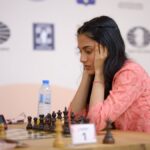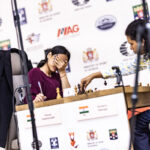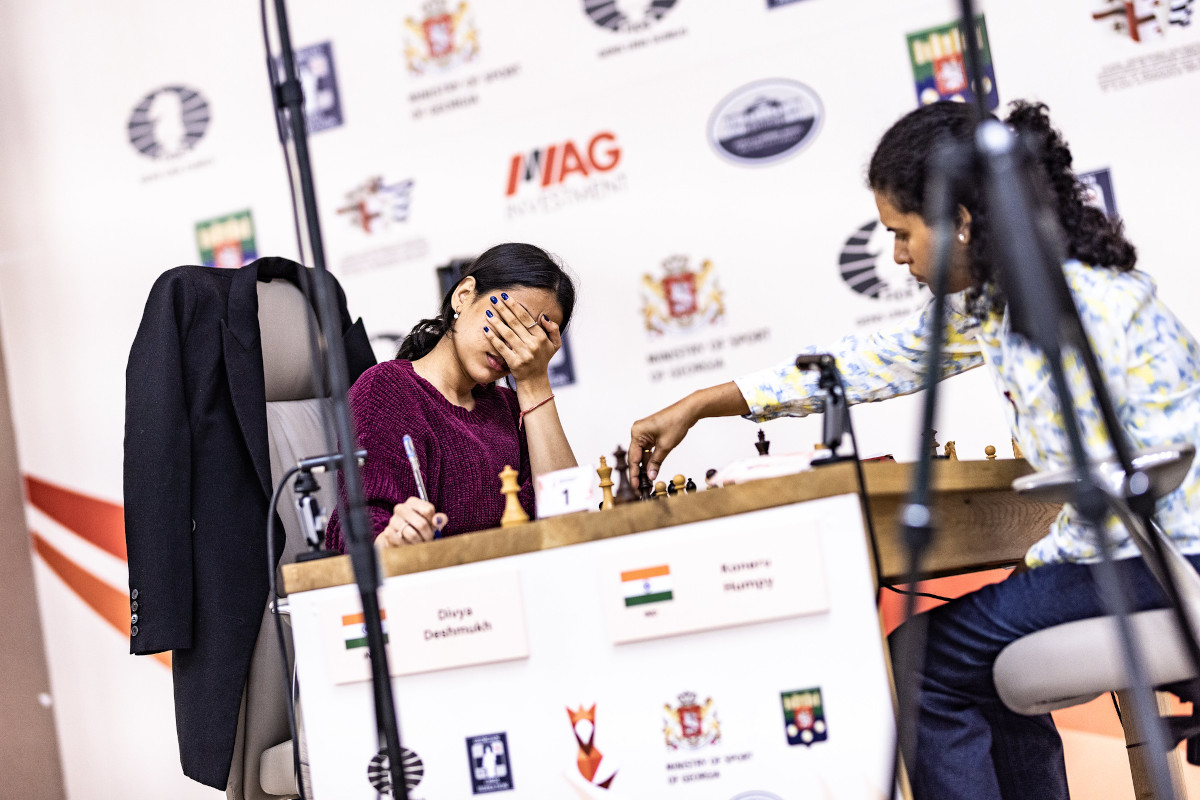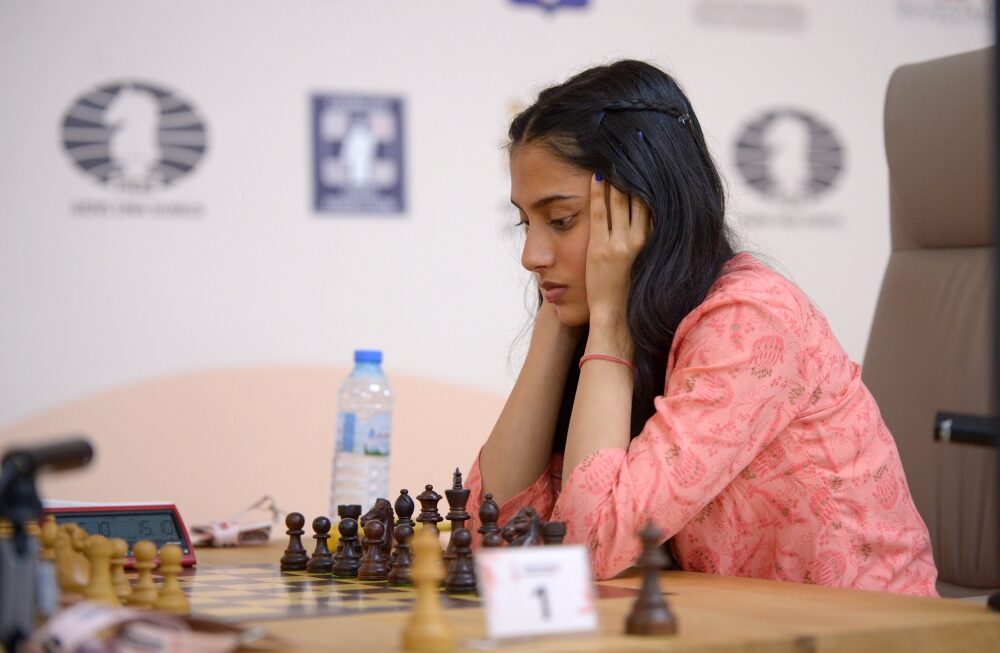Women’s Chess World Cup 2025: Complete Finals Analysis and Tournament Coverage
Finals Overview: Divya Deshmukh vs Humpy Koneru Battle in Batumi
Women’s Chess World Cup 2025: The Women’s Chess World Cup 2025 finals in Batumi have captivated the chess world as two of India’s most promising talents face off for the ultimate prize. We witnessed an electrifying first game between Divya Deshmukh and Humpy Koneru that showcased the highest level of competitive chess, with tactical fireworks and strategic depth that exemplified why this tournament stands as one of the most prestigious events in women’s chess.
Game 1 Analysis: Critical Moments and Missed Opportunities
The opening game of the finals demonstrated the razor-sharp preparation and nerves of steel required at this level. Divya Deshmukh, wielding the white pieces, opted for the Queen’s Pawn opening with 1.d4, immediately signaling her intention to steer the game into complex theoretical territory. Humpy Koneru’s response with the Queen’s Gambit Declined marked a strategic choice that would define the character of the entire encounter.
Opening Innovation and Strategic Surprises
We observed a fascinating departure from mainstream theory when Divya chose 7.Be2 instead of the more conventional 7.f3. This move, while not entirely novel, represents the kind of deep preparation that characterizes modern elite competition. The position transposed into a line that had historical precedent in the classic encounter between Evgeny Bareev and Vasyl Ivanchuk from Linares 1992, demonstrating how contemporary players continue to draw inspiration from chess history.
The critical juncture arrived when Humpy declined the e4 pawn with 7…Bb7, only to accept it after White’s castling with the sequence 8.0-0 Bxc3 9.bxc3 Nxe4. This pawn capture fundamentally altered the position’s dynamic balance and set the stage for the tactical complications that would follow.
The Tactical Storm: Move 10 and Beyond
Divya’s 10.Ba3 represented a profound positional understanding, preventing Black’s king from finding safety through castling. We witnessed the position explode into sharp tactical territory with Humpy’s response 10…Nd6, though post-game analysis revealed that 10…Nd7 would have offered superior defensive resources.
The game reached its most critical phase with Divya’s knight sacrifice 12.Nxc4, a move that perfectly embodied the attacking philosophy required in world championship-level play. While computer analysis suggests that 12.Rab1 might have maintained a more sustainable advantage, the psychological pressure created by the knight sacrifice demonstrates the human element that makes chess such a compelling spectacle.
Critical Decision Points and Game-Changing Moments
The Pivotal 13th Move
The position after 13.Re1+ presented both players with their most challenging decision of the game. Humpy’s choice of 13…Kf8 over the engine-preferred 13…Kd8 illustrates the complexity of calculating variations under tournament pressure. We witnessed a world-class player making an imperfect choice while acknowledging in post-game interviews that her intuition suggested the alternative was incorrect, though she couldn’t precisely identify why.
Divya’s Missed Winning Chance
The game’s most crucial moment occurred on move 14, where Divya had the opportunity to play the powerful 14.Qe2, which would have maintained her attacking initiative and placed Black in a nearly impossible defensive position. Instead, her choice of 14.Bxb7 allowed Humpy to equalize with precise defensive play through 14…Qxb7 15.Qe2 Nc6 16.d5 h5.
We can examine the critical variation that didn’t occur: after 14.Qe2 Nc6 15.d5 Qd7 16.dxc6 Bxc6 17.Bxc6 Bxc6 18.Bxd6+ cxd6 19.Qe7+, White would have achieved a clearly superior position with excellent winning prospects in the resulting heavy-piece endgame.
Third-Place Match: Tan Zhongyi vs Lei Tingjie
The battle for third place between Tan Zhongyi and Lei Tingjie provided its own strategic insights and demonstrated the depth of talent in women’s chess. We observed Tan’s opening choice of 1.c4, leading to the Exchange Variation of the Queen’s Gambit Declined, a line that has gained renewed attention in contemporary elite play.
Strategic Maneuvering and Positional Understanding
The game followed established theoretical lines until Tan’s 11.a4, a move that has appeared in recent games by world-class players including Fabiano Caruana and Praggnanandhaa Rameshbabu. This plan, designed to establish queenside control through a5 and cement the pawn structure, demonstrated the kind of deep positional understanding required at this level.
We witnessed a masterclass in patient maneuvering as both players navigated the complexities of the blocked position. Around moves 29-30, Tan’s slight inaccuracies allowed Lei to gain a minimal advantage, though the position remained objectively balanced throughout the middlegame phase.
Tournament Structure and Qualification Significance
Path to the Finals
The Women’s Chess World Cup 2025 represents one of the most important qualifying events in the chess calendar, with direct implications for the 2026 Women’s Candidates Tournament. We have observed throughout this tournament the incredible level of preparation and competitive intensity that characterizes modern women’s chess.
The tournament format, featuring knockout matches with classical games followed by rapid and blitz tiebreaks when necessary, creates drama and excitement while testing players’ skills across different time controls. This structure ensures that only the most well-rounded players can advance to the latter stages.
Stakes and Future Implications
The winner of this tournament will join the world’s elite in the next Candidates cycle, making every game crucial for the participants’ long-term career trajectories. We recognize that for young players like Divya Deshmukh, success here could launch a decade-long campaign for the world championship title.
Technical Analysis and Game Flow
graph TD
A[Opening: 1.d4] --> B[Queen's Gambit Declined]
B --> C[7.Be2 Innovation]
C --> D{Pawn on e4}
D -->|Declined| E[7...Bb7]
D -->|Accepted| F[8...Bxc3 9.bxc3 Nxe4]
F --> G[10.Ba3 - Prevents Castling]
G --> H[Knight Sacrifice 12.Nxc4]
H --> I{Critical Choice 13.Re1+}
I -->|13...Kf8| J[Missed 14.Qe2]
I -->|13...Kd8| K[Better Defense]
J --> L[14.Bxb7 - Equality]
L --> M[Draw After 41 Moves]
Endgame Technique and Time Management
The transition into the heavy-piece endgame showcased both players’ technical skills and psychological resilience. We observed Humpy’s practical decision-making when she declined to claim a draw by repetition on move 29, choosing instead to play for a win despite her earlier difficulties.
The time scramble that began after 30.Kh2 added another layer of complexity to an already challenging position. We witnessed both players demonstrating the kind of time management skills that separate elite competitors from the rest of the field.
Looking Ahead: Game 2 and Tiebreak Scenarios
Format and Expectations
Tomorrow’s second classical game will feature Humpy Koneru with the white pieces, creating an entirely different dynamic for the match. We anticipate that Humpy’s experience and the psychological boost from her successful defense in Game 1 will influence her opening preparation and overall approach.
Should Game 2 also end in a draw, the match will proceed to rapid tiebreaks, where both players’ skills in faster time controls will determine the championship. We have seen throughout the tournament that rapid games often produce more decisive results due to the increased time pressure and reduced opportunity for deep calculation.
Historical Context and Championship Significance
This Women’s Chess World Cup represents a milestone in the development of women’s chess, with unprecedented prize funds and global coverage highlighting the growing recognition of women’s achievements in the sport. We observe that tournaments like this continue to elevate the profile of women’s chess and inspire the next generation of players worldwide.
The level of play demonstrated in these finals matches the highest standards seen in contemporary chess, with both tactical complexity and strategic depth that would challenge any player regardless of gender. We witness in these games the culmination of years of preparation, training, and competitive experience.
Conclusion: Championship Chess at Its Finest
The Women’s Chess World Cup 2025 finals have already delivered memorable moments and demonstrated why this tournament ranks among the most prestigious events in the chess calendar. We have witnessed games that combine theoretical innovation, tactical fireworks, and psychological drama in a package that exemplifies championship-level competition.
As we await the conclusion of this remarkable final, we recognize that regardless of the ultimate winner, both Divya Deshmukh and Humpy Koneru have already cemented their places among the world’s elite players. Their performances in Batumi will be studied and admired by chess enthusiasts for years to come, representing the very best of what competitive chess has to offer.













